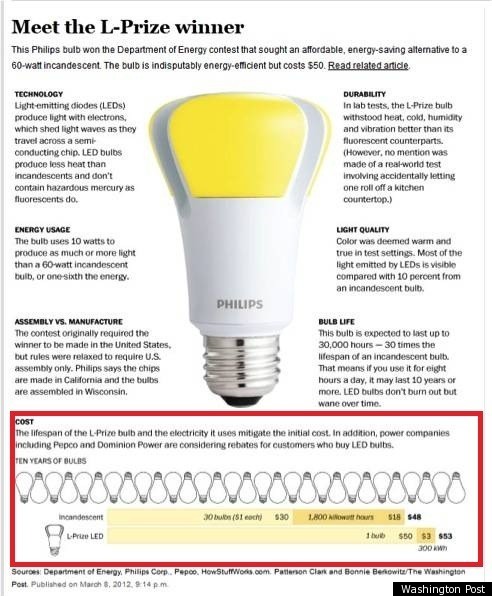
Washington Post staff writer Peter Whoriskey did his level-best last week to ridicule the Department of Energy for bestowing it's "L Prize" -- a "contest that sought an affordable, energy-saving alternative to a 60-watt incandescent" -- to an LED bulb manufactured by Phillips. But in the end, it was the paper's dim-bulb grasp of mathematics that caused a serious failure of illumination.
Your "L Prize" winning bulb has come to market, and it carries with it a $50 price, so some degree of sticker shock is understandable. Especially when one considers the relatively low cost of other light bulbs that do not offer the same energy-saving benefit. But, let's underscore that "energy-saving" part, shall we? Because that is sort of the entire point of these long-lasting bulbs that are designed to have a lower impact on your electricity bill. If you're the sort of person who doesn't routinely drop light bulbs on the ground, destroying them, this Phillips bulb is supposed to save you money over time.
This the Post endeavored to explain. But it seems that no one was on hand to explain the current per kilowatt cost of electricity, and so the energy the newspaper put into determining the long-term cost of buying the Phillips LED compared with 30 $1 incandescent bulbs was hopelessly skewed by the resulting round of Pre-K level innumeracy.
Here is the infographic that was originally produced with the article. Bless Mr. Whoriskey and his compatriots, they really, really thought they'd landed a major scoop!

If you direct your attention to the area bordered in red, you'll see that in the competition between one 10-year-lasting Phillips bulb versus 10 years worth of $1 incandescents, the cheapies win, because the bulb supply costs $20 less and the resulting energy expense only saves the Phillips owner $15. Stupid Department of Energy! They gave a prize to a bulb that costs $5 more!
Only they didn't, because as it turns out, in the actual world where humans live, the per-kilowatt cost of electricity is actually not $0.01. In 2011, the average U.S. cost per kilowatt hour for residential customers was actually $0.118. Thus, these calculations are off "by a factor of 10," give or take -- the level at which your math teacher starts handing out failing grades and perhaps a gentle talking-to about how maybe a career in number-crunching isn't something for which you should be aiming.
ThinkProgress went ahead and fixed this for the Washington Post, redoing the infographic so that it better comported with objective reality by doing the calculations with an assumed $0.10/kwh estimate. By those calculations, it was rather easily determined that the Phillips LED saved users $150 -- not $15 -- which meant that the "L Prize" winner truly lived up to its accolades, saving the 10-year customer $130.
At some point after all of this came to -- you know...light, the Post "silently excised the false section of their infographic online" and changed the cost-calculation section of their infographic to something more in line with reality. But there needs to be a correction, I'm afraid! I know this will be somewhat embarrassing for all involved, since the fact that this $0.01/kwh cost was pulled out of someone's ass and just assumed to be correct indicates that no one really even attempted to know what they were talking about before they just started graphing things and forming conclusions.
For the benefit of Mr. Whoriskey, I will include a link to the Post's guidelines for corrections, which should appear quite clearly on the screen of a standard laptop, regardless of how well lit the room is.
READ MORE:
Where’s the front-page correction? WashPost Fails Math, Fails Ethics, Fails Readers [Get Emergy Smart Now!]
[Would you like to follow me on Twitter? Because why not?]
